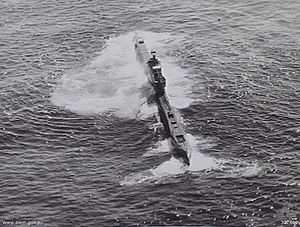HMS Proteus (N29)
For other ships of the same name, see HMS Proteus.
 | |
| Career (UK) | |
|---|---|
| Name: | HMS Proteus |
| Ordered: | 7 February 1928 |
| Builder: | Vickers Shipbuilding and Engineering, Barrow-in-Furness |
| Laid down: | 5 September 1928 |
| Launched: | 22 August 1929 |
| Commissioned: | 5 May 1930 |
| Fate: | Scrapped at Troon, Feb-Mar 1946 |
| General characteristics | |
| Class and type: | Parthian-class submarine |
| Displacement: | 1,788 long tons (1,817 t) surfaced 2,040 long tons (2,070 t) submerged |
| Length: | 289 ft (88 m) |
| Beam: | 30 ft (9.1 m) |
| Draught: | 15 ft 11 in (4.85 m) |
| Propulsion: | Diesel-electric 2 Admiralty diesel engines, 4,400 hp (3,300 kW) 2 Electric motors, 1,530 hp (1,140 kW) 2 shafts |
| Speed: | 17.5 knots (20.1 mph; 32.4 km/h) surfaced 9 kn (10 mph; 17 km/h) submerged |
| Range: | 8,500 nmi (15,700 km) at 10 kn (12 mph; 19 km/h) |
| Complement: | 53 |
| Armament: | • 8 × 21 in (533 mm) torpedo tubes (6 bow, 2 stern) • 1 × 4 in (102 mm) deck gun • 2 × machine guns |
| Notes: | Pennant number: N29 |
HMS Proteus was a Parthian-class submarine designed and built by Vickers Shipbuilding and Engineering in Barrow-in-Furness for the Royal Navy, and was launched on 22 August 1929. Like other submarines in her class she served in China before the war.
Proteus engaged and sank a number of German and Italian merchant ships, troopships, tankers and torpedo boats during her service in the Mediterranean in the Second World War. HMS Proteus was the longest surviving Parthian-class submarine and the only Parthian class submarine to survive the war.
Proteus had a total of nine commanders throughout the war.
References
- Information on Proteus
- Information on the British Submarines during WW2. Includes Information on the Parthian class and Proteus
- Information on the Parthian Submarine class. Includes Information on Proteus
| ||||||||||